We were somewhere around Angkor Thom on the edge of the jungle when the drugs began to take hold. Yes, I’ve been waiting for the opportunity to rip off Hunter Thompson’s most famous opening line, modified for the setting. My second visit to Cambodia, this one centering on a trip to Phnom Penh, and channeling Hunter is unavoidable; Cambodia simmers with a Dalisque aura. Hunter would have been in ecstacy. But I’ve gotten ahead of myself. Let’s go back to daybreak.
The hotel was dark and the neighborhood quiet as I made my way down to the lobby to meet my tuk tuk driver Tony for a day exploring the ancient temples outside of Siem Reap. It was early. The local roosters had not yet started their insistent crowing. I felt a minor pang of guilt at having to wake the bell hop to unlock the gate at the front of the hotel’s compound for me. While you sleep, a padlock protects you from the dangers of the Cambodian night. I knew from my previous trip to Siem Reap that a predawn start was necessary to see the wats before thousands of touri descend upon them. More importantly, I was hoping to avoid the gaggle of snot nosed grubby Khmer kids that wait in mass at the entrance to every major historical site in Cambodia, pestering you to buy their postcards and books.
Tony was running late. Cambodian time. But the country’s torpid life-style had already creeped into my system, so I was mellow and unconcerned about the time passing as I sipped my coffee, sharing the small soi with nothing but a few sleeping dogs. My plan was to head to Angkor Thom and the Bayon Temple first. Angkor Wat, its larger and more prestigious cousin, is a more popular spot to catch the sunrise. But I’m not a morning person. Sharing that moment with hundreds of my fellow travelers just didn’t have an appeal. And I prefer the Bayon’s ruins and colossal heads in any case.
Half an hour later Tony came puttering up the street, the unmuffled engine of his tuk tuk waking the dogs from their slumber. He was drunk. Or hung over. Somewhere in between the two. A friend’s sister had been married the night before and Tony had been out partying into the early hours. The normal vividness of the whites of his eyes had a dark and bruised look about them. Being chauffeured through 1,000 year old temples by a drunk native fit Cambodia perfectly. I dropped a valium, took the last sip of my cooling coffee and climbed aboard for the 20 minute ride to the Angkor Wat complex’s main gate.
The weather was perfect, just a slight bit of chill in the morning air. The locals were bundled up in heavy coats. Freezing for them, not quite the ‘work up a sweat from simply breathing’ humidity typical of SE Asia for me. A perfect time to hit the entrance, we’d missed the sunrise multi-bus caravan and beat the after-breakfast crowd. You need to buy a pass to visit the various wats within the complex. A one day pass runs $20 and it’s issued with your picture on it so you can’t later pass it off to a friend. Hard to scam a scammer in Cambodia. The process of getting the pass only took 5 minutes. Hit the entrance booths with the crowds and it can take an hour or more. There are also 3 and 7 days passes available, but I was taking it one day at a time. Who knew what I’d feel like doing tomorrow? No reason to add a sense of urgency to the lazy days of bucolic bliss ahead.
Everyone warns you about the danger of land mines in Cambodia. No one warns you about the potholes. I think the latter do more damage. Tony tried slowing and avoiding the worst. More out of concern for the hangover induced throbbing in his head than for my comfort. No problemo. And thank you Hunter: we were somewhere around Angkor Thom on the edge of the jungle when the drugs began to take hold. And my body was pothole proof.
Angkor is Khmer for city. Thom? Dunno. Maybe some guy’s name. Angkor Thom comprises a large area of land with several well known temples and ancient structures. The most impressive being the Bayon. Most touri say Angkor Thom when they mean the Bayon. Most say Angkor Wat when they are getting ready to make a bad pun. And you’re welcome; I haven’t yet done so. They’ll also say Angkor Wat when they mean Siem Reap (the town closest to the temples). Angkor Wat is a temple. It is also the name of the complex that covers all of the main wats outside of Siem Reap; that includes Angkor Wat and Angkor Thom. It’d be confusing if anyone really cared.
Most touri enter Angkor Thom through the South gate. It’s an impressive entrance. The street is lined with Hindu cosmology and imagery, one side flanked with demons, the opposing side with gods. The forces of good and evil play out the same regardless of one’s religious preference. Tony pulled over to attempt summonsing up enough energy to spout the typical touri intro speech. I took pity on him, reminded him I’d been there before, and waved him on. No need to stop, there were bigger heads just up the road.
The Bayon in the morning light is an impressive sight. Shadowed stone walkways give way to massive quarried columns alive with the morning sun. The lower levels of the temple are reminiscent of the crumbled ruins of ancient Rome The sight of a saffron robed monk picking his way over the jumble of ruins reminds you you’re in Asia. A photographer’s wet dream. I’m in heaven as I stumble through dark passages and climb the steep narrow laterite stairs to be greeted by gargantuan, enigmatic grinning faces, the pride and prime focus of the Bayon.
There are 54 massive sandstone towers at the Bayon, each bearing carved stone heads displaying serene expressions, closed eyelids and thick, slightly curled lips, They stare out over the surrounding jungle. Some say they are Buddhas, others the likeness of King Jayavarman VII who had the temple built in what was his capital city. The less argumentive claim the faces are a combination of the two. Make up your own story. Chances are you’ll be just as correct. Some are close enough to touch. Others soar over head. New facades come into view as you turn each corner. A local man demands I sit on the deteriorating ledge of a stone window to have my photo taken nose to nose with one of the immense smiling heads. A trick of perception and camera angles. He’s too insistent for me to refuse. And then doesn’t ask for a tip after the shot has been taken. That’s Cambodia: the urchins guarding the entrance demand extortion for useless postcards, the picture of you at the Bayon is free.
It’s early enough in the day the temple has yet to see the thousands of touri it will experience in just a few short hours. I share the ruins with a tour group from Japan, not usually my favorite brand of touri as they are rude, pushy, and travel in herds. But this is a small group. Buddhist monks and their guide. They are dressed in deep plum colored robes and I take more photos of them than I do of the surrounding structures. My wet dream just became a deluge of orgiastic pleasure. I love taking pictures of monks.
Deep within the temple’s dark crevasses, old women playing the role of nuns maintain small shrines. From my previous visit I knew the drill. Stop, kneel, light some incense and say a quick prayer. Drop a few riel in the box. The more generous of mind will consider this making merit. The more realistic know that it’s but a bribe to be allowed to take their picture. My thousand riel donation earns me yet another colorful yarn bracelet to add to my growing collection. I’ve been blessed, yet again. And it only cost me a quarter.
I spend hours at the Bayon, circling the temple again and again, taking different paths up and down the narrow corridors each time. New vistas greet me on each round; new photo ops appear at every angle. Lichen litters the walls that spend the day in shadows. The elements have conspired to paint the stone the colors of the Louisiana swamp. Dusky greens give way to brittle roots of brown, evidence of vegetation that tried to once gain hold. Surprising hues of purple stretch across the archways overhead. On the plazas its a monochromatic world of grey occasionally broken by faded orange cloth draped on stumps of decaying statues of Buddha. By the time I hop off the last sandstone block, the sun has begun to beat mercilessly down through the sparsely planted trees. A touri glides by on the back of an elephant. An old Khmer woman stops sweeping the walkway to pose while I take her picture.
I rest for awhile under the skimpy shade of an silk tree, chatting with an old Aussie guy, an expat living in Viet Nam. His hands are full of postcards and he bitches about the local brats blocking the temple’s entrance demanding ‘only one dollah, sir!’ to allow him to pass. I laugh and think, “Yeah, and you just added to the problem.”
A middle-aged English woman approaches me in panic. Her’s was an unexpected trip while visiting a son in Bangkok. She’d borrowed his camera; the batteries are dead. She wants to know if I have any to spare. What, I look like a 7/11? It’s probably not an unusual occurrence, and those damn ragamuffins could be making a killing selling batteries instead of books. But that would make too much sense. This is Cambodia after all.
Signs lead you past the Phimeanakas temple, a smaller pyramidal wat, past the Terrace of the Elephants, and over the ruins of the Terrace of the Leper King. It’s not like you have a choice or need directions; you have to go this way to get to where the tuk tuk drivers wait for their customers. The last part of the trail conveniently takes you away from the main road and through a gauntlet of merchants, aggressively pushing bad paintings, poorly carved statues, knick knacks proudly bearing the stamp ‘Made in China’, and yes, more postcards and books. I try a new response for variety if nothing else. “Not shopping today!” I say, only to have a disgruntled vendor sneeringly repeat my refrain to her neighbor. I stop at the next stall to browse for a while, just to piss her off.
As the walkway lined with stalls crammed full of cheap trinkets snakes back toward the road, I head off in the opposite direction. Yes, the road not taken and all that jazz. A small compound nestled in the trees waits just around the bend. Buddhist monks sit on the verandahs of crumbling wood structures that look incapable of bearing their weight. Further in a local man squats in supplication, his hands forming a reverent wai before a young monk who is dumping pan after pan of water over his head. Washing away his sins? Or is that too Christian of an interpretation? I know it’s a photo few touri will get to take.
I brave the final mob of sellers and mafioso rug rats to get to where Tony and his tuk tuk wait. “Postcard for you, sir,” the little demons cry. “Only one dollah,” as they follow along not willing to give up the chase.
One little girl with beautiful eyes and a dirt smeared face tags along beside me, her hands empty of the usual paraphernalia. She smiles sweetly and in her sing song English offers, “Sir! For one dollah I give you pees and quite.” Sold. I laugh and hand her a pocketful of worthless riel. She beams, and makes good on her promise. I walk off alone in the quiet afternoon, savoring my good luck and the silence I’ve paid for.
>>> Next ‘Fear and Loathing in Phnom Penh’ Post
<<< Previous Fear and Loathing in PhnomPenh Post
Related Posts You Might Enjoy:

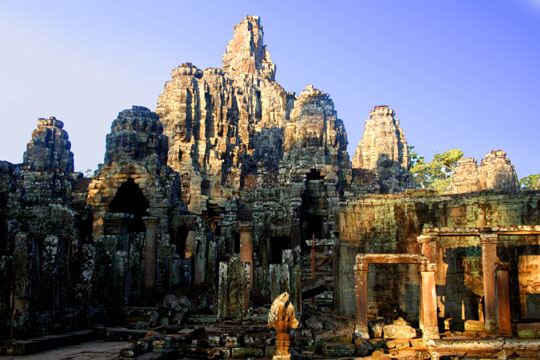



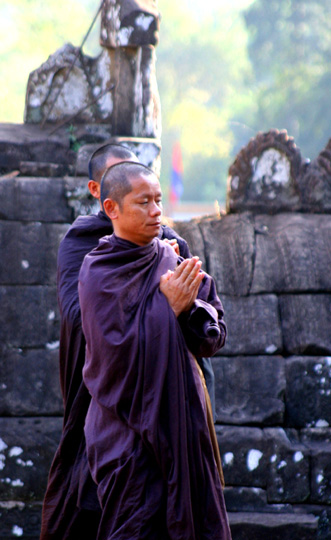
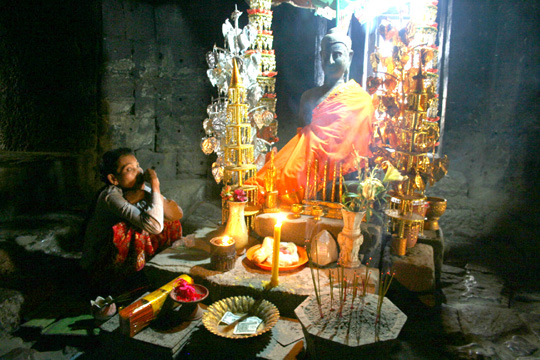
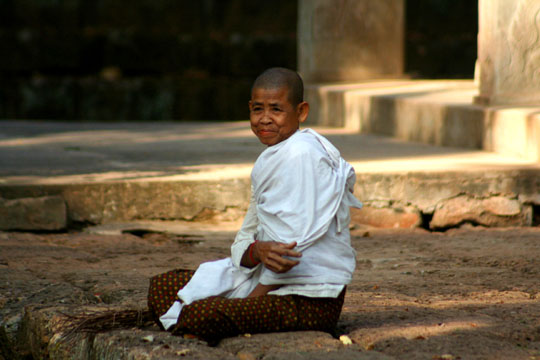

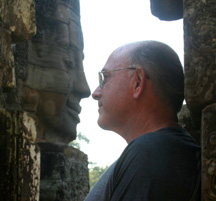



Wonderful story of visiting the Khmer Temples!! Fortunately I went there 10 years ago. Much more enjoyable then. And now at 70 I would not be climbing up to face nose to nose with a Bayon… Hope there are more stories to come!!!
Cheers…
Thank you George!
Hard to describe with words how incredible those temples are . . . glad to hear you got to see them while you could still make your way over the stumbling blocks they consider paths!
That’s really freaking funny.
🙂
I was glad to read you survived your bus ride to the wilds of Siem Reap Kim!